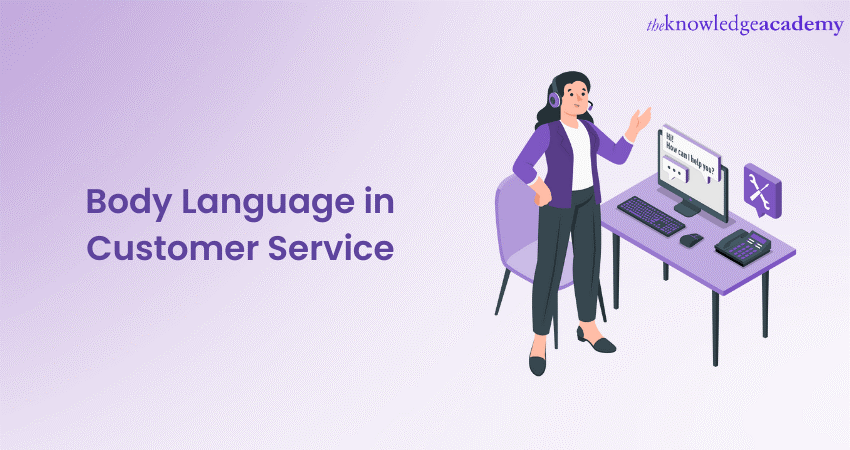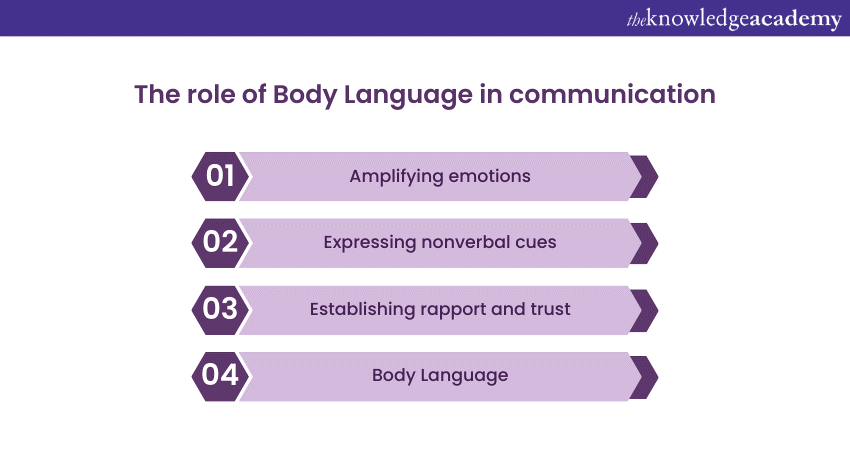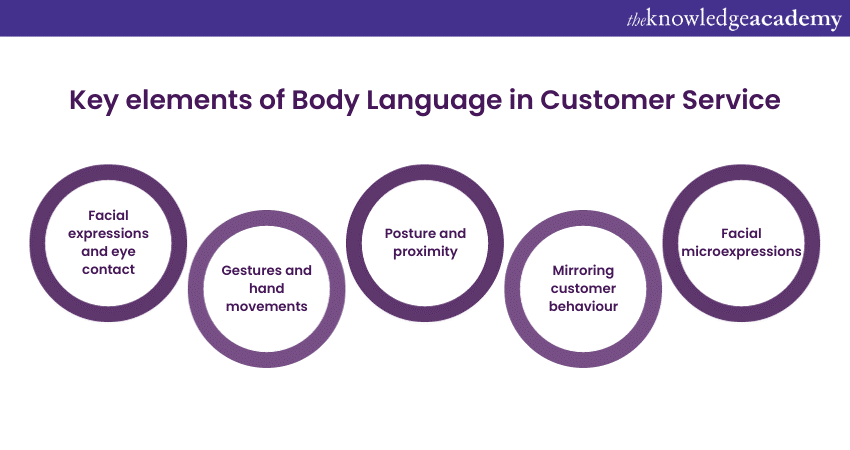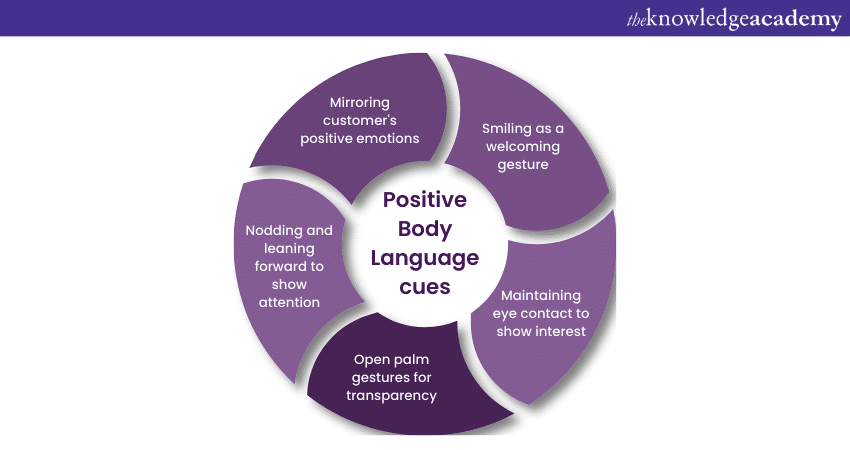We may not have the course you’re looking for. If you enquire or give us a call on 01344203999 and speak to our training experts, we may still be able to help with your training requirements.
Training Outcomes Within Your Budget!
We ensure quality, budget-alignment, and timely delivery by our expert instructors.

Body Language takes centre stage in communication, adding depth and nuance to every interaction. It is a language that transcends borders, cultures, and languages, speaking volumes through gestures, expressions, and postures. In this blog, we will embark on a journey to uncover the profound impact of Body Language in Customer Service. Keep reading to learn more!
Table of Contents
1) The role of Body Language in communication
2) Key elements of Body Language in Customer Service
3) Positive Body Language cues in Customer Service
4) Training and improving Body Language
5) Conclusion
The role of Body Language in communication
While words serve as the explicit conveyors of information, the nuances of Body Language often speak louder than any sentence uttered. The unspoken language of body movements, facial expressions, and posture adds depth, richness, and context to our words. In communication, Body Language shapes the message, influences relationships, and fosters understanding.

Amplifying emotions
Have you ever witnessed that an easy smile could light up a room? That is the magic of Body Language. It magnifies emotions, making them palpable and relatable. Imagine a friend sharing exciting news with you. As they animatedly recount their experience, their hands might move enthusiastically, their eyes shining bright. These nonverbal cues emphasise the happiness they feel, adding a layer of authenticity to their words.
Expressing nonverbal cues
Often, what we do not say is as important as what we say. When someone clenches their fists, their jaw tightens, and their brow furrows, you can instantly tell that they are frustrated or angry. These nonverbal cues provide insights into a person's emotional state or mindset. When applied to Customer Service, understanding these cues can help tailor your responses to effectively address concerns, even if they are not explicitly stated.
Establishing rapport and trust
Imagine entering a store, and the salesperson meets your gaze with a genuine smile and a welcoming nod. You are more likely to feel comfortable and open to engaging with them. That is because positive Body Language can create a sense of rapport and trust. When individuals mirror each other's movements, it unconsciously signals that they are on the same page. This can be a game-changer in Customer Service, as customers are more likely to trust a representative who exhibits open and friendly Body Language.
Elevate your Customer Service game with our Exceptional Customer Service Training!
Key elements of Body Language in Customer Service
This section of the blog will expand on the key elements of Body Language in Customer Service.

Facial expressions and eye contact
Your face is a canvas of emotions, and customers are keen observers. A genuine smile, not just with your lips but reaching your eyes, immediately puts customers at ease. It signals approachability and warmth, setting a positive tone for the conversation.
Gestures and hand movements
A single gesture might not reveal much, but they form gesture clusters that convey a more comprehensive message when grouped together. For example, crossed arms, furrowed brows, and limited eye contact might indicate defensiveness or disagreement. Understanding these clusters helps you interpret customers' feelings accurately.
Furthermore, your hands are powerful tools for conveying information. Open palm gestures signify transparency and honesty – pointing with an open hand is less aggressive than a pointed finger. Controlled hand movements can emphasise critical points during explanations, making your message more transparent and memorable. However, excessive or erratic hand movements might come across as anxious or unprofessional.
Posture and proximity
How you carry yourself tells volumes regarding your confidence and level of comfort. Standing or sitting up straight exudes professionalism and attentiveness. Leaning slightly forward can demonstrate active listening and engagement while leaning back might indicate relaxation or disinterest. Be mindful of personal space; invading a customer's bubble can make them uncomfortable, while standing too far away might create a disconnect.
Mirroring customer behaviour
Mirroring involves subtly imitating a customer's Body Language and pace. If a customer speaks slowly and with measured gestures, mirroring these cues can create a sense of familiarity and comfort. However, reflecting should be done subtly to avoid sounding insincere or mocking.
Facial microexpressions
Microexpressions are brief facial expressions that reveal underlying emotions. While you might be skilled at maintaining a pleasant exterior, microexpressions can reveal your true feelings. Training yourself to manage these microexpressions is crucial, as customers can pick up on the slightest signs of irritation or impatience.
Enhance your customers’ experience by registering for our Exceptional Customer Service Training!
Positive Body Language cues in Customer Service
This section of the blog will expand on the positive Body Language cues you must incorporate when it comes to Body Language:

Maintaining eye contact to show interest
Eyes are windows to our intentions and emotions. Maintaining appropriate eye contact demonstrates an active interest in their concerns when engaging with customers. It signals that you are fully present in the conversation and genuinely attentive to their needs. Avoid excessive staring, which can be uncomfortable, and remember that cultural differences might influence the appropriate eye contact level.
Open palm gestures for transparency
Open palms are symbols of honesty, transparency, and goodwill. Using empty palm gestures during interactions helps convey that you have nothing to hide and are genuinely here to assist. For instance, when explaining something, extending your hand with the palm facing up can visually emphasise your willingness to share information. This gesture subconsciously puts customers at ease, creating a sense of trust.
Nodding and leaning forward to show attention
Nodding in agreement while customers speak communicates that you are actively listening and processing their words. Leaning slightly forward reinforces your attentive stance. This combination of cues assures customers that their concerns matter and that you are engaged in understanding their perspective. It is essential to avoid excessive nodding, as it can seem insincere or like you are rushing them.
Mirroring customers’ positive emotions
Mirroring involves subtly imitating a customer's positive Body Language cues. If a customer is visibly excited or enthusiastic, reflecting their energy through your gestures and expressions can build rapport. It creates a sense of shared experience and connection. However, be cautious not to overdo it; mirroring should be done subtly and naturally.
Smiling as a welcoming gesture
When customers express concerns or share their experiences, your facial expressions should reflect empathy. A furrowed brow or a concerned face can show that you understand and take their situation seriously. A warm smile coupled with verbal responses like "I understand" or "I'm here to help" reinforces your commitment to their needs.
Training and improving Body Language
This section of the blog will suggest you with tips to train and improve your Body Language.
Engaging in workshops
Engaging in workshops specifically focused on Body Language can provide valuable insights and techniques. These sessions often combine theory with practical exercises, enabling you to practice different postures, gestures, and expressions in controlled environments. Role-playing scenarios in real-world interactions, allow you to experiment with various Body Language cues and receive constructive feedback.
Recording customer interactions
Recording your customer interactions on video can offer a unique perspective. By reviewing the footage, you can identify areas for improvement, spot gestures that might convey unintended messages, and assess your overall Body Language. This self-reflection helps you become more aware of your nonverbal cues and make conscious adjustments.
Accepting feedback
Feedback from colleagues, mentors, or supervisors is invaluable. Others might notice subtleties in your Body Language that you are unaware of. Constructive criticism and practical suggestions can guide your progress and provide fresh insights.
Incorporating cues into your Body Language habits
Practice makes perfect, and integrating new Body Language habits into daily interactions is essential. Focus on incorporating one or two specific cues at a time to avoid overwhelming yourself. For example, start by consistently maintaining steady eye contact or using open gestures.
Developing self-awareness is a cornerstone of improving Body Language. Cultivate mindfulness during interactions, paying attention to your cues and the reactions they elicit from customers. This self-awareness empowers you to make real-time adjustments for more effective communication.
Conclusion
This comprehensive exploration embraces the nuances of Body Language in the domain of Customer Service. It empowers you to read between the lines, to connect deeply, and to leave an indelible imprint on every customer interaction. So, let your Body Language be a symphony of authenticity, a canvas of respect, and a bridge that spans cultures, connecting hearts and minds alike.
Discover the key to unlocking your potential and achieving personal growth with our comprehensive Personal Development Training!
Frequently Asked Questions
Upcoming Business Skills Resources Batches & Dates
Date
 Exceptional Customer Service Training
Exceptional Customer Service Training
Fri 9th Aug 2024
Fri 25th Oct 2024
Fri 27th Dec 2024
Fri 31st Jan 2025
Fri 4th Apr 2025
Fri 13th Jun 2025
Fri 22nd Aug 2025
Fri 24th Oct 2025
Fri 12th Dec 2025







 Top Rated Course
Top Rated Course



 If you wish to make any changes to your course, please
If you wish to make any changes to your course, please


